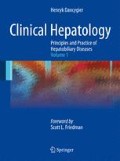Access this chapter
Tax calculation will be finalised at checkout
Purchases are for personal use only
References
Bissel DM (1986) Heme catabolism and bilirubin formation. In: Ostrow JD (ed) Bile pigments and jaundice. Marcel Dekker, New York, pp 133–56
Brown MS, Goldstein JL (1986) A receptor-mediated pathway for cholesterol homeostasis. Science 232: 34–47
Chawla A, Repa JJ, Evans RM, et al (2001) Nuclear receptors and lipid physiology: opening the X-files. Science 294: 1866–70
Chiang J Y, Kimmel R, Weinberger C, et al (2000) Farnesoid X receptor responds to bile acids and represses cholesterol 7alpha-hydroxylase gene (CYP7A1) transcription. J Biol Chem 275: 10918–24
Carey MC, Cohen DE (1987) Biliary transport of cholesterol in vesicles, micelles and liquid crystals. In: Paumgartner G, Stiehl A, Gerok W (eds) Bile acids and the liver. MTP Press, Lancaster, pp 287–300
Cohen DE, Leonard MR, Carey MC (1994) In vitro evidence that phospholipid secretion into bile may be coordinated intracellularly by the combined actions of bile salts and the specific phosphatidylcholine transfer protein of liver. Biochemistry 33: 9975–80
Goodwin B, Kliewer SA (2002) Nuclear receptors. I. Nuclear receptors and bile acid homeostasis. Am J Physiol Gastrointest Liver Physiol 282: G926–31
Hagenbuch B, Meier PJ (1996) Sinusoidal (basolateral) bile salt uptake systems of hepatocytes. Semin Liver Dis 16: 129–36
Hofmann AF (1990) Bile acid secretion, bile flow and biliary lipid secretion in humans. Hepatology 12: 17S–22S
Hofmann AF (1999) The continuing importance of bile acids in liver and intestinal disease. Arch Intern Med 159: 2647–5
Holan KR, Holzbach RT, Hermann RE, et al (1997) Nucleation time: a key factor in the pathogenesis of cholesterol gallstone disease. Gastroenterology 77: 611–7
Kakis G, Yousef IM (1980) Mechanism of cholic acid protection in lithocholate-induced intrahepatic cholestasis in rats. Gastroenterology 78: 1402–11
Keppler D, Kö;nig J, Leier I, et al (1997) ATP-dependent transport of dianionic bile salts by the canalicular isoform of the multidrug resistance protein (MRP2/cMRP/cMOAT). In: Paumgartner G, Stiehl A, Gerok W (eds) Bile acids in hepato-biliary diseases. Kluwer, Dordrecht/Boston, MA, pp 129–36
Kunze D, Rüstow B (1993) Pathobiochemical aspects of cytoskeleton components. Eur J Clin Chem Clin Biochem 31: 477–89
Landrier JF, Eloranta JJ, Vavricka SR, et al (2006) The nuclear receptor for bile acids, FXR, transactivates human organic solute transporter-alpha and -beta genes. Am J Physiol Gastrointest Liver Physiol 290: G476–85
Leuschner U, Güldütuna S, Bhatti S, et al (1995) Cytotoxicity and membrane protection by bile acids. In: Meyer zum Büschenfelde KH, Paumgartner G, Schö;lmerich J (eds) Perspectives in gastroenterology. Current facts and future trends. Urban & Schwarzenberg, München, pp 153–64
Leuschner U, Schneider M, Loos R, et al (1977) Morphologic investigations on the toxicity of orally applied CDCA in the liver, gastrointestinal tract, kidney and adrenal gland of the rat. Res Exp Med 171: 41–55
Luna LJ, Hitt AL (1992) Cytoskeleton-plasma membrane interactions. Science 258: 955–64
Makishima M, Okamoto AY, Repa JJ, et al (1999) Identification of a nuclear receptor for bile acids. Science 284: 1362–5
Nathanson MH, Boyer JL (1991) Mechanisms and regulation of bile secretion. Hepatology 14: 551–65
Nies AT, Gatmaitan Z, Arias IM (1996) ATP-dependent phosphatidylcholine translocation in rat liver canalicular plasma membrane vesicles. J Lipid Res 37: 1125–36
Paumgatner G, Sauerbruch T (1991) Gallstone pathogenesis. Lancet 338: 1117–21
Stremmel W, Tiribelli C, Vylka K (1993) The multiplicity of sinusoidal membrane carrier systems of organic anions. In: Tavoloni N, Berk PD (eds) Hepatic transport and bile secretion. Raven, New York, pp 225–34
Turley SD, Dietschy JM (1988) The metabolism and excretion of cholesterol by the liver. In: Arias IM, Jacoby WB, Popper H, et al (eds) The liver. Biology and pathology. Raven, New York, pp 617–41
Vanstapel F, Blanckaert N (1988) Topology and regulation of bilirubin UDP-glucuronyltransferase in sealed native microsomes from rat liver. Arch Biochem Biophys 63: 216–25
Whitmer DI, Hauser SC, Gollan JL (1984) Mechanisms of formation, hepatic transport, and metabolism of bile pigments. In: Okuda K, Nakayama F, Wong J (eds) Intrahepatic calculi. Risss, New York, pp 29–52
Zucker SD, Storch J, Zeidel ML, et al (1992) Mechanism of the spontaneous transfer of unconjugated bilirubin between small unilamellar phosphatidylcholine vesicles. Biochemistry 31: 3184–92
Author information
Authors and Affiliations
Rights and permissions
Copyright information
© 2010 Springer-Verlag Berlin Heidelberg
About this chapter
Cite this chapter
Leuschner, U. (2010). Formation and Secretion of Bile and Bilirubin Metabolism. In: Clinical Hepatology. Springer, Berlin, Heidelberg. https://doi.org/10.1007/978-3-540-93842-2_7
Download citation
DOI: https://doi.org/10.1007/978-3-540-93842-2_7
Publisher Name: Springer, Berlin, Heidelberg
Print ISBN: 978-3-540-93841-5
Online ISBN: 978-3-540-93842-2
eBook Packages: MedicineMedicine (R0)

